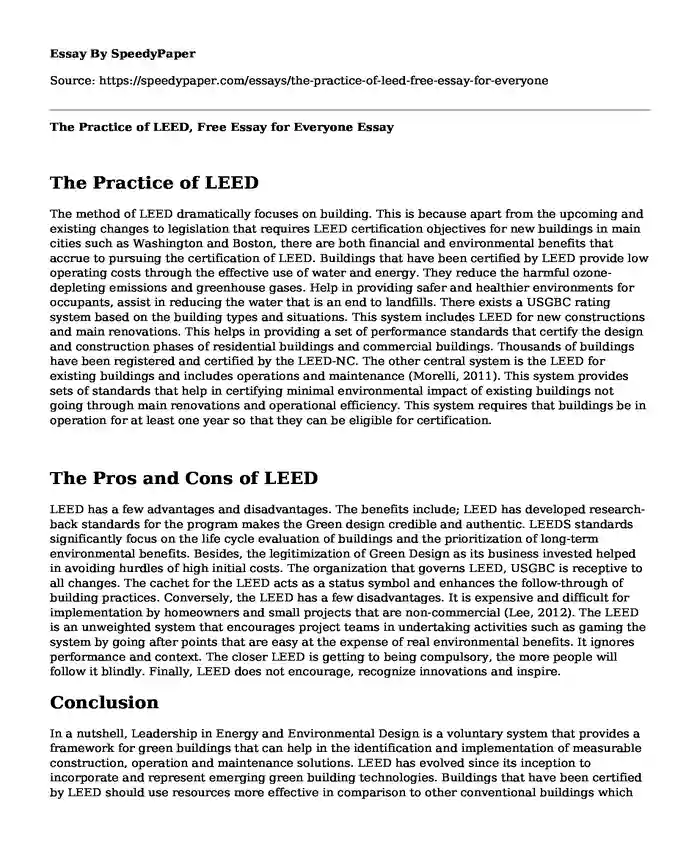
| Type of paper: | Essay |
| Categories: | Environment Energy |
| Pages: | 2 |
| Wordcount: | 550 words |
The Practice of LEED
The method of LEED dramatically focuses on building. This is because apart from the upcoming and existing changes to legislation that requires LEED certification objectives for new buildings in main cities such as Washington and Boston, there are both financial and environmental benefits that accrue to pursuing the certification of LEED. Buildings that have been certified by LEED provide low operating costs through the effective use of water and energy. They reduce the harmful ozone-depleting emissions and greenhouse gases. Help in providing safer and healthier environments for occupants, assist in reducing the water that is an end to landfills. There exists a USGBC rating system based on the building types and situations. This system includes LEED for new constructions and main renovations. This helps in providing a set of performance standards that certify the design and construction phases of residential buildings and commercial buildings. Thousands of buildings have been registered and certified by the LEED-NC. The other central system is the LEED for existing buildings and includes operations and maintenance (Morelli, 2011). This system provides sets of standards that help in certifying minimal environmental impact of existing buildings not going through main renovations and operational efficiency. This system requires that buildings be in operation for at least one year so that they can be eligible for certification.
The Pros and Cons of LEED
LEED has a few advantages and disadvantages. The benefits include; LEED has developed research-back standards for the program makes the Green design credible and authentic. LEEDS standards significantly focus on the life cycle evaluation of buildings and the prioritization of long-term environmental benefits. Besides, the legitimization of Green Design as its business invested helped in avoiding hurdles of high initial costs. The organization that governs LEED, USGBC is receptive to all changes. The cachet for the LEED acts as a status symbol and enhances the follow-through of building practices. Conversely, the LEED has a few disadvantages. It is expensive and difficult for implementation by homeowners and small projects that are non-commercial (Lee, 2012). The LEED is an unweighted system that encourages project teams in undertaking activities such as gaming the system by going after points that are easy at the expense of real environmental benefits. It ignores performance and context. The closer LEED is getting to being compulsory, the more people will follow it blindly. Finally, LEED does not encourage, recognize innovations and inspire.
Conclusion
In a nutshell, Leadership in Energy and Environmental Design is a voluntary system that provides a framework for green buildings that can help in the identification and implementation of measurable construction, operation and maintenance solutions. LEED has evolved since its inception to incorporate and represent emerging green building technologies. Buildings that have been certified by LEED should use resources more effective in comparison to other conventional buildings which are built merely. Buildings that have been LEED certified provide healthier living and work environments which significantly contribute to improved employee comfort and health and higher productivity.
References
Anderson, J. E., Wulfhorst, G., & Lang, W. (2015). Energy analysis of the built environment-A review and outlook. Renewable and Sustainable Energy Reviews, 44, 149-158.
Lee, W. L. (2012). Benchmarking energy use of building environmental assessment schemes. Energy and Buildings, 45, 326-334.
Morelli, J. (2011). Environmental sustainability: A definition for environmental professionals. Journal of Environmental Sustainability, 1(1), 2.
Cite this page
The Practice of LEED, Free Essay for Everyone. (2022, Sep 09). Retrieved from https://speedypaper.net/essays/the-practice-of-leed-free-essay-for-everyone
Request Removal
If you are the original author of this essay and no longer wish to have it published on the SpeedyPaper website, please click below to request its removal:
- How to Get Inspired to Write - Free Essay for Students
- Essay Sampe: Socrates' Argument on Rhetoric Use
- Free Essay Sample on the Evolution of Digital Art
- Art Essay Sample: The Hidden Emotions in the Images of the Tale of Genji
- Free Essay Offering Solutions to Organ Trafficking
- Essay Sample on Second Language Class Evaluation
- Free Essay: The Cultural Influence of My Behavior on Cosmetics
Popular categories




